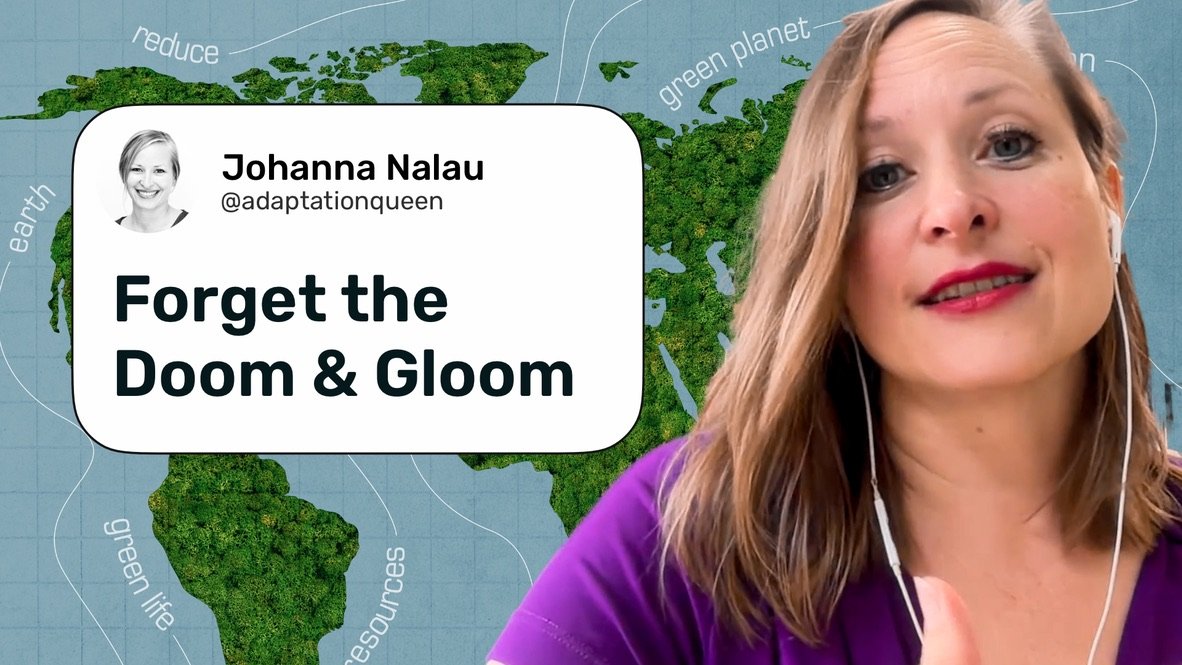What happens when we fix climate change? With Johanna Nalau
TL;DR Let's explore climate adaptation with A/Prof. Johanna Nalau: Where does climate mitigation end and adaptation start, how can we implement these strategies today, and what is the role of imagination in facing climate change impacts?
This entry is a deep dive into our conversation with Johanna, so read at your own pace! :)
Unpacking climate adaptation
In our latest podcast, we sat down with A/Prof Johanna Nalau, an adaptation scientist & contributor to the IPCC, to learn more about climate adaptation.
As she explained, it’s not just about reducing emissions anymore... the effects of climate change are already here. Adaptation is our chance to prepare for extreme weather and rethink what it means to live in a changing world. Johanna puts it simply:
“Adaptation is about making better decisions today, to keep us safer in the future.”
With mitigation we focus on reducing the root causes of climate change (I.e. cutting emissions and transitioning to renewable energy). We aim to slow down the processes behind global warming and prevent future climate impacts.
Adaptation, on the other hand, is about adjusting to the climate impacts we are already experiencing. It involves preparing communities, ecosystems, and infrastructure to cope with extreme weather, rising sea levels, and other changes.
While mitigation prevents future harm, adaptation allows us to live safely in a changing biosphere. So, let's zoom in, what could adaptation look like and what can we learn from the challenges ahead? 👇
Implementing adaptation
Below are some of the adaptation strategies and challenges we got to cover during the interview.
Note: this is by no means an exhaustive list. If you want to know more, we highly suggest reading the IPCC report*
*Fun fact: Johanna was lead author for the 6th Assessment report 'Chapter 15: Small Islands' and the 'Summary for Policymakers'.
1. Nature-based solutions 🏝️
One of the most powerful strategies is using nature itself. Nature-based solutions, such as restoring wetlands to manage floods or planting mangroves to prevent coastal erosion, work with the environment rather than against it.
However, these solutions are context-specific. "Not every ecosystem can support the same solutions," Johanna explains. These strategies require a deep understanding of local ecosystems to make sure that solutions help, instead of harm, our environment.
2. Governance vs local action 👔
Local actions alone won’t solve climate issues unless they are supported by state and national policies.
For instance, in some areas, local governments want to plan for sea-level rise based on the current predictions, but state regulations may set lower benchmarks... which prevents them from implementing robust adaptation strategies. These misalignments need to be addressed for meaningful progress to be made (more on this later!)
3. Long-term planning & transformative change 📅
A major challenge of implementing adaptation is that the benefits often take decades to become noticeable, which makes it hard to justify immediate investments (especially in the current political climate).
Yet, cities like Copenhagen have shown the value of long-term thinking, upgrading their infrastructure today to avoid huge costs in the future.
In other cases, adaptation requires us to shift land use and how we interact with the environment. One example is turning coastal farmland into nature reserves (to prevent erosion and boost biodiversity). However, we've seen that this is often met with resistance because of cultural and historical ties to the land. “We must respect that these shifts are not easy for communities,” Johanna notes. “Changing the way people view their land is just as important as the physical changes we make.”
As you can imagine from the list above, this means we'll need adequate leadership to pull us through this major transition. Part of that is working on the flow of information👇
Leading us to a resilient future
Communication between scientists, policymakers, and the public... let's say it can be better. A lot of this has to do with improving our soft skills. Here's how we can make that happen.
Science to Policy
Johanna points out that policymakers often feel overwhelmed by the volume of scientific data and struggle to translate it into actionable policies.
They need accessible information, and guidance on what works best for their specific context.
Policy to Public
Adaptation is not just top-down or bottom-up, it requires collaboration at every level.
This means local governments must have a seat at the table, supported by state and national regulations, while incorporating feedback from the communities they serve.
Public to Society
This is where all of us come in: Johanna challenges us individuals, particularly in the climate community, to step up and take up our leadership roles.
Leadership doesn’t have to come from traditional positions of power... “It’s about helping others understand what’s possible and propelling them forward,” she explains. Where can you take action in your local community?
It doesn't matter if you are a scientists, policy maker, creator or community member, we can all lead the adaptation process forward! 👇
Imagining a Thriving World
One of the most inspiring ideas Johanna brings to the table is 'the role of imagination'. She challenges us to move beyond the doom & gloom and start imagining a thriving, climate resilient future.
But here's something we didn't see coming, and it might take you a minute as well. Johanna asked us two questions:
What would the world look like if we had no climate action?
What if we actually make all the necessary changes, what would that world look like then?
While most of us can vividly imagine the world through climate inaction (e.g. degraded ecosystems, water scarcity, extreme weather... I could keep going on and on), it's a lot harder to imagine a future where we’ve succeeded in our climate goals.
“Adaptation is about imagining a world where we live in balance with nature, where ecosystems thrive alongside cities. If we can inspire people to imagine that future, we can motivate them to act."
And with that, we have one last question for you. Think about it during your commute, your next coffee, or while you lay awake at night:
It's 2040 We made it! What does your local city look like?
Let us know, and we'll gather all of your inspirational thinking for an upcoming post! (DM us on Instagram @creatorsforclimate)
Listen to the episode!
Video Podcast
Audio Podcast
Or click here to listen on other players
Links and further reading
Connect with Johanna
https://www.instagram.com/adaptationqueen/
https://www.linkedin.com/in/a-prof-johanna-nalau-6517a633/
Resources:
IPCC Sixth Assessment Report – https://www.ipcc.ch/reports/?rp=ar6
Resilience Frontiers – https://resiliencefrontiers.org/
2040 Vision Exercise – https://resiliencefrontiers.org/pathway-storylines/
Books mentioned
- "Artificial Wisdom" by Tom Weaver
- "Why Do So Many Incompetent Men Become Leaders?" by Tomas Chamorro-Premuzic
- "Dare to Lead" by Brené Brown
As always, we value your feedback. Let us know what you think of our first episode and what topics you'd like us to cover in the future. Your input helps us shape our content to better serve our community of climate creators.








